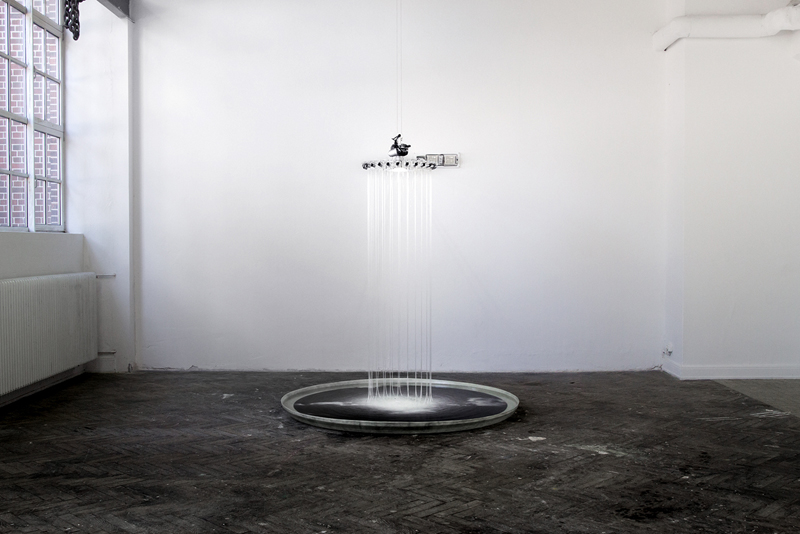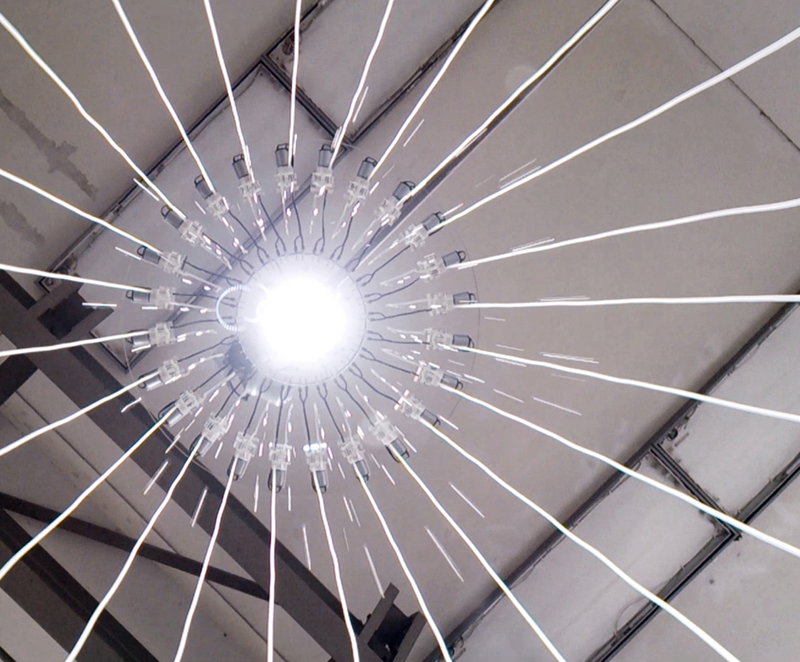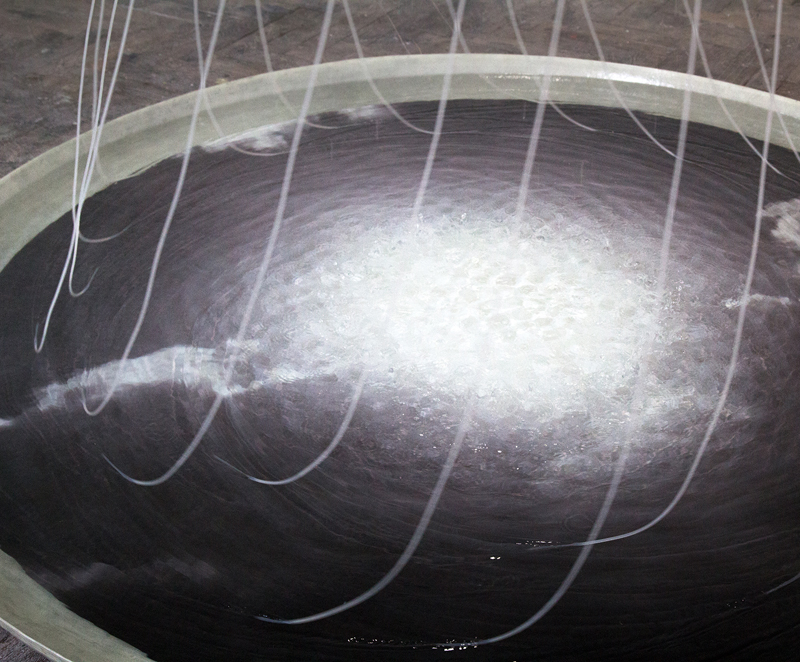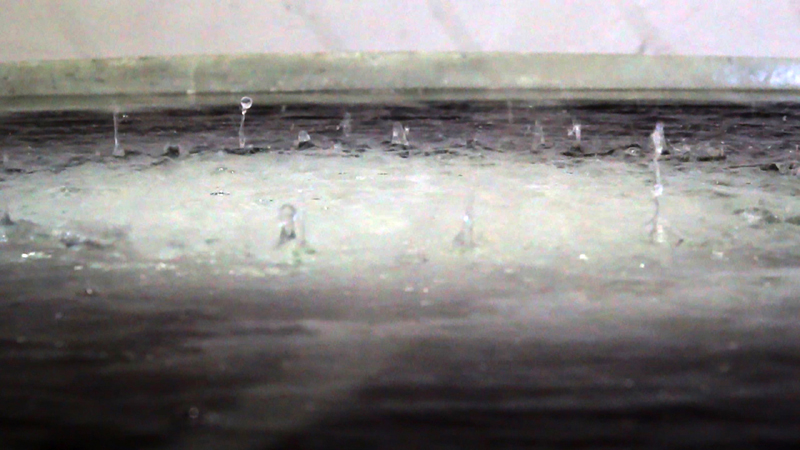






 Like
Ice in the Sunshine
Like
Ice in the Sunshine2014
zeitbezogene Installation / time-based installation
2,20 × 3,60 × 2,80 m
12minütiger Rhythmus / 12-minute rhythm
Kunststoff, Metall, UV-Druck, Elektronik, Wasser / plastics, metal, UV-printing, electronics, water
The time-based work passes through four
cycles and has a total running time of twelve minutes. The top section
consists of an acrylic glass pane connected to a motor. 24 circular
pumps and a ring-shaped lamp are attached to the lower surface. The
bottom section of the work consists of a 2.20 m spherical basin filled
with water in which a dramatic black-and-white photograph of a sunny
cloudburst is depicted. 24 hoses, hanging loosely in the water basin,
are attached to the pumps: These hoses, which are at intervals both
dynamic and passive, form the connection between both sections of the
work.
The first cycle begins audibly with the start of the pumps and lamp. The pumps carry water from the basin up to the pane through the hoses, which subsequently rains down in the direction of the cloudburst. Against the soundscape of engine whirrs and the splash of water, a circular wave and resonance pattern emerges in the basin. In the second cycle the motor rotates the pane, causing the hoses to swing outwards from the basin's centre, thereby optically exposing the falling rain drops. The third cycle begins with the deactivation of the lamp and pumps. The hoses continue to slide through the water, creating a hypnotising spiral pattern above the cloudburst; the motor continues to provide a consistent medium frequency purr. The third cycle merges into the fourth and final cycle: the sound of the motor stops altogether and the hoses start their return to the centre of the basin as the centrifugal force declines. Concurrently, the clattering sound of the idling chain drive becomes less and less audible. The hoses return to their initial position; the water returns to stasis. A six-minute dormant phase follows before the first cycle begins again.
The first cycle begins audibly with the start of the pumps and lamp. The pumps carry water from the basin up to the pane through the hoses, which subsequently rains down in the direction of the cloudburst. Against the soundscape of engine whirrs and the splash of water, a circular wave and resonance pattern emerges in the basin. In the second cycle the motor rotates the pane, causing the hoses to swing outwards from the basin's centre, thereby optically exposing the falling rain drops. The third cycle begins with the deactivation of the lamp and pumps. The hoses continue to slide through the water, creating a hypnotising spiral pattern above the cloudburst; the motor continues to provide a consistent medium frequency purr. The third cycle merges into the fourth and final cycle: the sound of the motor stops altogether and the hoses start their return to the centre of the basin as the centrifugal force declines. Concurrently, the clattering sound of the idling chain drive becomes less and less audible. The hoses return to their initial position; the water returns to stasis. A six-minute dormant phase follows before the first cycle begins again.
Die zeitbezogene Arbeit durchläuft vier
Zyklen und hat eine Gesamtlaufzeit von zwölf Minuten. Ihr oberer Teil
besteht aus einer, an einen Motor gekoppelten Acrylglasscheibe, an deren
Unterseite 24 ringförmig angeordnete Pumpen und eine ringförmige Lampe
befestigt sind. Der untere Teil besteht aus einem 2,20 m großen, mit
Wasser gefüllten Rundbecken, in welches die dramatische
Schwarz-Weiß-Fotografie eines sonnigen Wolkenbruchs eingearbeitet ist.
24 an den Pumpen angebrachte und lose im Wasserbecken endende Schläuche
verbinden beide Teile der Arbeit.
Der erste Zyklus beginnt mit dem hörbaren Anspringen der Pumpen und der Lampe. Die Pumpen transportieren Wasser durch die Schläuche aus dem Becken zu der Scheibe hinauf und lassen es anschließend in Richtung Wolkenbruch hinabregnen. Unter einem surrenden Motorengeräusch und Wasserplätschern entsteht hierbei ein kreisförmiges Wellen- und Resonanzmuster im Becken. Im zweiten Zyklusteil lässt der Motor die Scheibe rotieren, wobei die Schläuche vom Zentrum des Wasserbeckens nach außen schwingen und dabei die fallenden Regentropfen optisch freilegen. Der dritte Zyklus beginnt mit dem Ausschalten der Lampe sowie der Pumpen. Die weiterhin durch das Wasser gezogenen Schläuche erzeugen ein hypnotisierendes Spiralmuster über dem Wolkenbruch und werden untermalt von dem gleichbleibenden, mittelfrequenten Ton des Motors. Der dritte Zyklus geht mit dem plötzlichen Wegfallen des Motorgeräuschs in den vierten und letzten über. Unter der immer geringer werdenden Zentrifugalkraft bewegen sich die Schläuche zunehmend zurück Richtung Beckenzentrum. Es verbleibt das selten werdende, klackernde Geräusch der sich im Leerlauf befindenden Antriebskette. Die Schläuche nehmen ihre Ausgangsposition ein, der Wasserwirbel löst sich vollständig auf. Es folgt eine sechsminütige Ruhephase.
Der erste Zyklus beginnt mit dem hörbaren Anspringen der Pumpen und der Lampe. Die Pumpen transportieren Wasser durch die Schläuche aus dem Becken zu der Scheibe hinauf und lassen es anschließend in Richtung Wolkenbruch hinabregnen. Unter einem surrenden Motorengeräusch und Wasserplätschern entsteht hierbei ein kreisförmiges Wellen- und Resonanzmuster im Becken. Im zweiten Zyklusteil lässt der Motor die Scheibe rotieren, wobei die Schläuche vom Zentrum des Wasserbeckens nach außen schwingen und dabei die fallenden Regentropfen optisch freilegen. Der dritte Zyklus beginnt mit dem Ausschalten der Lampe sowie der Pumpen. Die weiterhin durch das Wasser gezogenen Schläuche erzeugen ein hypnotisierendes Spiralmuster über dem Wolkenbruch und werden untermalt von dem gleichbleibenden, mittelfrequenten Ton des Motors. Der dritte Zyklus geht mit dem plötzlichen Wegfallen des Motorgeräuschs in den vierten und letzten über. Unter der immer geringer werdenden Zentrifugalkraft bewegen sich die Schläuche zunehmend zurück Richtung Beckenzentrum. Es verbleibt das selten werdende, klackernde Geräusch der sich im Leerlauf befindenden Antriebskette. Die Schläuche nehmen ihre Ausgangsposition ein, der Wasserwirbel löst sich vollständig auf. Es folgt eine sechsminütige Ruhephase.
